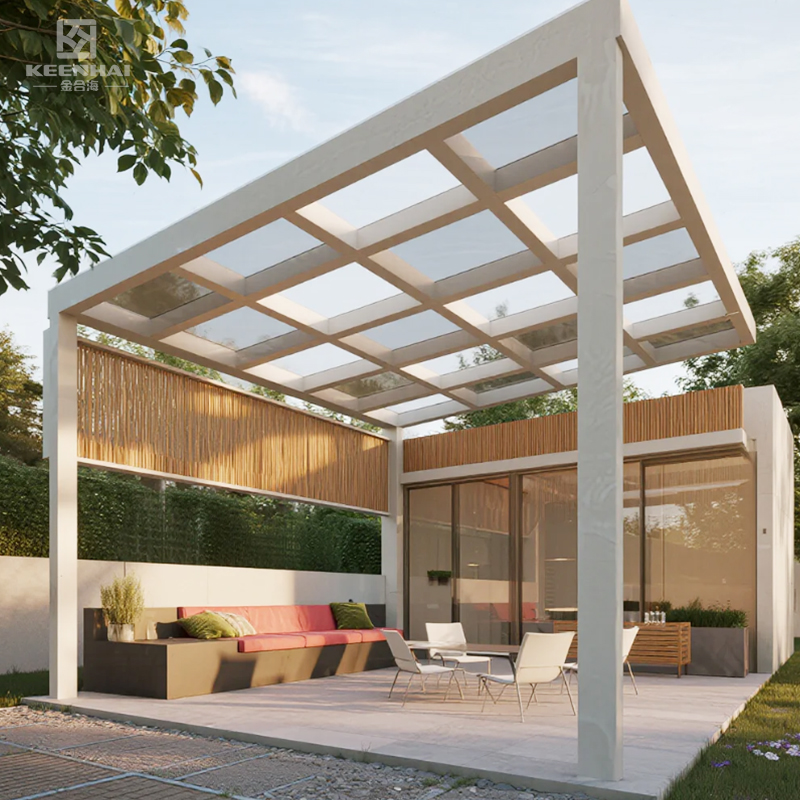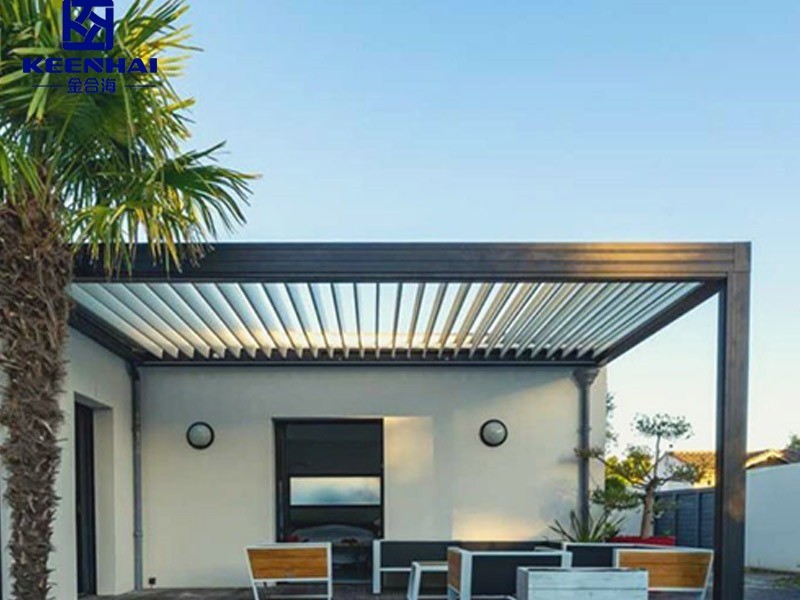
1. Cost and Value Comparison
1.1 Initial Purchase Price
The upfront cost is usually the first thing homeowners compare. A classic wooden gazebo may seem cheaper at first glance, especially if you choose pressure-treated pine or cedar. But the numbers tell a different story once you factor in ongoing treatments and potential repairs. Many homeowners now prefer investing in a modern louvered pergola in aluminum because the initial cost includes durability features like powder coating and rust resistance. For instance, a client in Florida installed one in their backyard patio, and despite paying more upfront, they avoided the annual $500–$700 expense for wood staining and sealing.
| Feature | Wood Gazebo (Average) | Aluminum Louvered Pergola (Average) |
|---|---|---|
| Initial Price (10x12 ft) | $2,000 – $3,500 | $4,000 – $6,500 |
| Annual Maintenance | $300 – $800 | $50 – $100 |
| Expected Repairs in 10 Years | Frequent (rot, cracks, repaint) | Minimal (rare hardware replacements) |
1.2 Long-Term Investment and ROI
Looking at long-term ROI, aluminum structures consistently win out. A wooden gazebo adds charm but can lose resale value if not perfectly maintained. In contrast, an aluminum louvered roof gazebo holds its appeal for decades, often boosting property value because buyers see it as a “low-maintenance upgrade.” Realtors in California report that homes with adjustable aluminum pergolas sell 5–7% faster in competitive markets.
In real life, one homeowner in Arizona shared that after installing a sleek aluminum metal roof gazebo, their outdoor dining space became the centerpiece of family gatherings. Five years in, the structure looks brand new, and they have spent less than $100 on upkeep compared to thousands with their old cedar pavilion.

2. Durability and Weather Resistance
2.1 Resistance to Sun, Rain, and Snow
Wood and aluminum react very differently under the elements. Cedar and redwood gazebos handle moderate rain well but often fade or crack after years of sun exposure. Heavy snow can also warp beams if they aren’t reinforced. By contrast, an Aluminum Louvered Pergola resists UV damage, sheds rain through its adjustable louvers, and won’t buckle under snow loads when engineered correctly. In northern states like Michigan, many homeowners choose aluminum because the powder coating protects the surface even after harsh winters.
2.2 Lifespan of Aluminum vs Wood
When maintained, high-quality wood gazebos last about 10–15 years before major repairs are needed. Aluminum frames, on the other hand, can easily exceed 20–25 years with only basic cleaning. A homeowner in Denver shared that their cedar gazebo required repainting every other year, while their neighbor’s aluminum pergola house still looks sharp after 12 years, with no signs of decay.
| Factor | Wood Gazebo | Aluminum Pergola |
|---|---|---|
| Average Lifespan | 10–15 years | 20–25+ years |
| Sun Resistance | Low (fades easily) | High (UV protected coating) |
| Rain Resistance | Moderate (needs sealant) | Excellent (built-in drainage) |
| Snow Load Tolerance | Low to medium | High with reinforced beams |
2.3 Warping, Cracking, and Rust Issues
Wood tends to expand and contract with temperature changes, which often leads to warping or splitting. Even treated lumber is not immune to these issues in humid regions. Aluminum structures eliminate these headaches. Instead of warping, they may face minor cosmetic scratches, but these can be touched up without structural risk. Importantly, rust is not a concern because the frames are usually powder-coated. In coastal areas, many families have switched from wood to an Aluminum waterproof pergola since salt air quickly eats away at untreated timber but has little effect on coated aluminum.

3. Maintenance and Upkeep
3.1 Cleaning Requirements
Wood gazebos require frequent cleaning to prevent mold, mildew, and insect buildup. Typically, owners wash the surfaces every 2–3 months with a mild detergent, then allow the structure to dry completely before applying any protective coating. In contrast, an aluminum louvered pergola only needs a simple rinse with a garden hose and, at most, a light scrub once or twice a year. A homeowner in Florida mentioned that after a tropical storm, they simply hosed down their aluminum pergola, while their neighbor spent hours scrubbing algae off a cedar frame.
3.2 Painting, Sealing, and Repairs
Wood maintenance is ongoing. Every 1–2 years, it usually needs:
-
Sanding down rough or splintered areas.
-
Applying a waterproof sealant or stain to fight moisture.
-
Replacing warped or rotted beams if damage has occurred.
By comparison, powder-coated aluminum structures don’t need painting or sealing. The finish is baked onto the frame, so it resists peeling and fading. Minor scratches can be touched up with a color-matched spray, but major repairs are rare. Many owners appreciate this hands-off approach, especially when the pergola is used as an outdoor dining space, where the last thing you want is peeling wood chips landing on your table.
3.3 Time and Cost of Regular Care
Over time, the cost of maintaining a wood gazebo often rivals its original purchase price. Between sealants, stains, paint, and occasional structural repairs, expenses can add up quickly. More importantly, the time investment is significant—weekends spent sanding and staining are not unusual. On the other hand, an Aluminum metal roof gazebo is close to maintenance-free. Owners usually budget only a small amount for occasional cleaning supplies.
| Factor | Wood Gazebo | Aluminum Pergola |
|---|---|---|
| Cleaning Frequency | Every 2–3 months | 1–2 times per year |
| Painting/Sealing | Every 1–2 years | Not required |
| Repair Costs (10 yrs) | High (beam replacement, refinishing) | Low (rare touch-ups) |
| Time Investment | 10–20 hrs/year | 2–3 hrs/year |

4. Design and Aesthetic Appeal
4.1 Style Flexibility and Customization
Aluminum gazebos give homeowners far more freedom when it comes to design. They can be crafted with clean, modern lines or softened with decorative trims to blend into a traditional setting. Wood gazebos, while beautiful, are often limited by the natural grain and structural strength of the timber. In many backyard renovation projects, aluminum frames allow designers to add sliding screens, integrated lighting, or even motorized louvers—features that are much harder to achieve with wood.
4.2 Natural Look of Wood vs Modern Aluminum
Wood undeniably carries warmth and a rustic charm. A cedar gazebo in a countryside home, for instance, blends effortlessly with the greenery and creates an inviting retreat. On the other hand, aluminum gazebos shine in urban settings, where a crisp, matte black or powder-coated finish fits seamlessly with contemporary landscaping and glass patio doors. In real estate developments, aluminum gazebos are often chosen for model homes because they look sleek while still being practical for long-term use.
| Feature | Wood Gazebo | Aluminum Gazebo |
|---|---|---|
| Style Vibe | Warm, rustic, traditional | Sleek, modern, versatile |
| Customization | Limited by grain & structure | Flexible: finishes, trims, tech add-ons |
| Best Use Case | Country homes, garden retreats | Urban patios, luxury backyards |
4.3 Color and Finish Options
When it comes to finishes, wood typically relies on stains or paint, both of which need reapplication every few years to maintain a polished look. Aluminum, in contrast, benefits from powder coating technology that delivers a durable, UV-resistant surface in virtually any color. Imagine a coastal property where salty air quickly weathers wood; an aluminum gazebo with a white powder coat will hold its fresh look for decades. This balance between aesthetics and longevity is exactly why many homeowners exploring premium outdoor living spaces turn to keenhaipergola, where customization meets durability without compromise.
